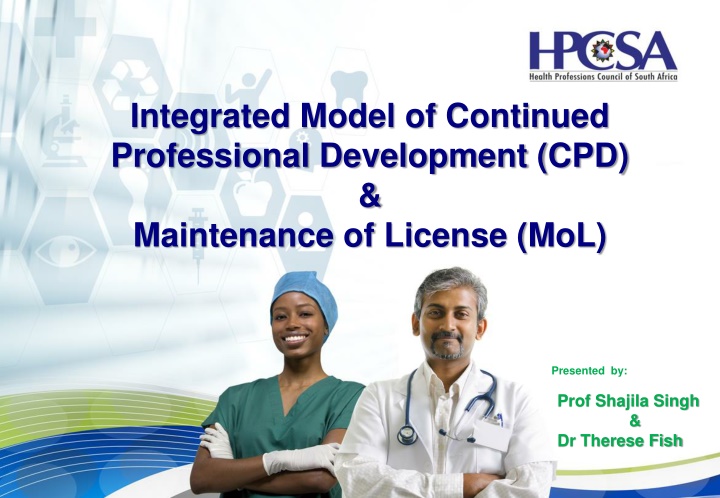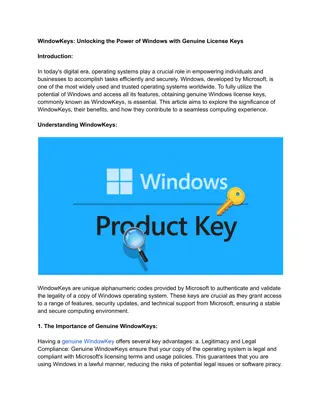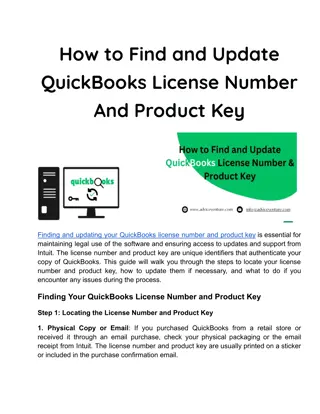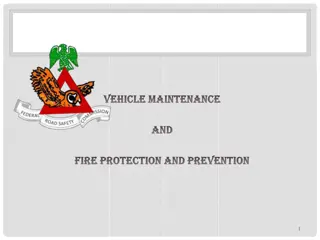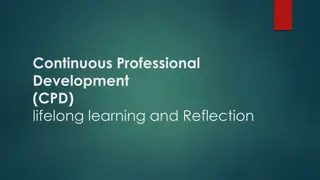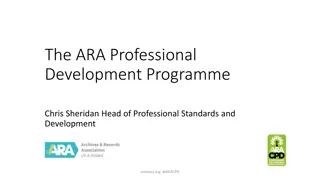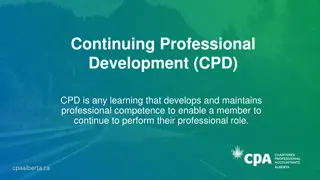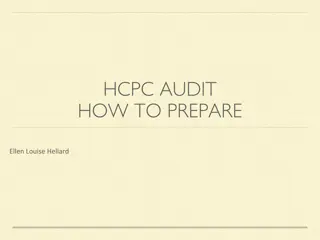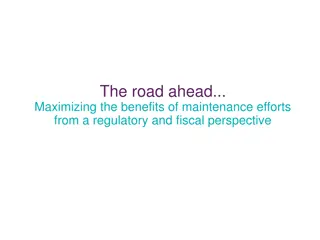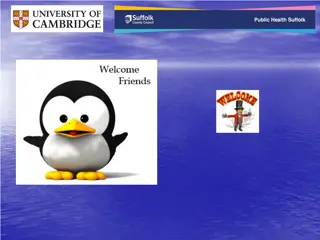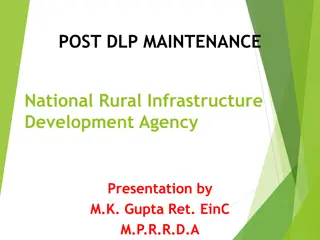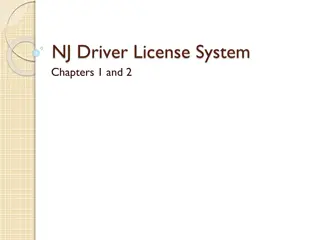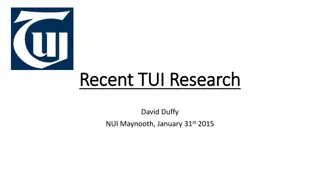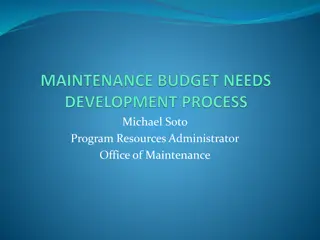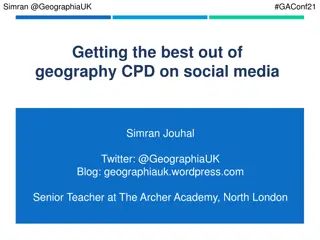Integrated Model of Continued Professional Development (CPD) & Maintenance of License (MoL)
Presented by Prof. Shajila Singh and Dr. Therese Fish, the integrated model explores the purpose, challenges, and response to current CPD practices by HPCSA. It emphasizes the need for practitioners to maintain and enhance their professional knowledge, skills, and performance for better outcomes in patient care and health systems. The discussion delves into the differences between registration and licensing, the primary goal of MoL, shortcomings of traditional CPD approaches, and the evolving response of HPCSA towards a more comprehensive and impactful CPD framework aligned with MoL.
Download Presentation

Please find below an Image/Link to download the presentation.
The content on the website is provided AS IS for your information and personal use only. It may not be sold, licensed, or shared on other websites without obtaining consent from the author.If you encounter any issues during the download, it is possible that the publisher has removed the file from their server.
You are allowed to download the files provided on this website for personal or commercial use, subject to the condition that they are used lawfully. All files are the property of their respective owners.
The content on the website is provided AS IS for your information and personal use only. It may not be sold, licensed, or shared on other websites without obtaining consent from the author.
E N D
Presentation Transcript
Integrated Model of Continued Professional Development (CPD) & Maintenance of License (MoL) Presented by: Prof Shajila Singh & Dr Therese Fish
STRUCTURE OF THE PRESENTATION Introduction - Registration vs Licence Purpose of Maintenance of Licence (MoL) Challenges with current CPD & HPCSA response Rationale for MoL Integrated model for CPD and MoL Where are we in the process? Questions 2
INTRODUCTION REGISTRATION VS LICENSE LICENSE oHPCSA 2013: practitioners required to have a license to practice profession oWith licensure: demonstrate compliance with Board s requirements o5-year licensure credentialing cycle REGISTRATION o 2007 CPD compulsory: professions registered with the HPCSA o Goal: Encourage update of knowledge and skills for ethical & competent practice o Currently: registration on an annual basis to practice profession o HPCSA conducts random checks on adherence 3
PRIMARY PURPOSE FOR MOL Ensure that all Practitioners maintain and improve their Professional Knowledge, Skills and Performance for improved patient/client and health systems outcomes 4
SO WHY NOT CPD? Current focus of CPD: Primarily Continuing Education (CE) to update knowledge; Research: Acquired knowledge meaningful only when it offers an opportunity for a change in practice; Translation of knowledge into practice - not optimal with a lag between acquiring knowledge and applying it in practice (Mickan, 2014, Wallace and May, 2016) ; Lag impact profound (Wallace and May, 2016) o30% to 40% of patients don t receive care informed by best evidence; o20% to 50% receive inappropriate care. 5
THE HPCSA RESPONSE HPCSA critically reflected on current CPD program considering research & international trends; CPD should be: patient / client centered, more comprehensive, include a wide range of learning activities (not only CE), focus on improved practice and outcomes and be linked to MoL; Goal: guide genuine learning & enable improvement of professional competence and performance. 6
SHIFT IN THINKING [CPD] Currently CPD requires practitioners to record the number of credits Equating number of continuing education units (CEUs) with competence is erroneous (Ahmed, et al, 2013) & doesn t indicate genuine learning or change performance quality 2013 HPCSA survey - 67.5% of practitioners, across Boards, engaged with CPD because it was a mandatory expectation of the HPCSA 7
SHIFT IN THINKING [CPD] There is a need to move from engaging with CPD because it is Mandatory using CPD for improving practice Currently, many practitioners meet mandatory CPD CEUs opportunistically, erratically or casually (Ahmed, et al., 2013) CPD impact limited when undertaken in an ad hoc manner, and contributes little to improved clinician performance or patient/client health outcomes (Wallace & May, 2016). 8
EVIDENCE FOR COMPREHENSIVE CPD FOR MOL Learning activities that enhance participant activity, use multiple exposures to content, encourage reflection on current practices, provide opportunities to practice skills and help clinicians identify gaps between current performance and an identified standard Often result in highly significant changes in practice and patient outcomes (Wallace & May 2016). 9
RATIONALE FOR MOL Comprehensive CPD Models - practitioners set out their CPD requirements and demonstrate how their CPD activities improve their professional performance and patient/client health Such models recognize that different professionals will have different development needs and require practitioners to take greater ownership of their professional development The new HPCSA Model will shift control of learning to individual health practitioners, enabling them to reflect on their learning needs and to design their own learning programmes (Institute of Medicine, 2009) 10
RATIONALE FOR MOL CONT. Input-based systems (Wallace & May 2016) like CPD in South Africa - delivered primarily through lectures, conferences & workshops (HPCSA CPD Survey 2013) Such systems are simple, cost effective and provide an easily quantifiable method of measuring individual CPD activity (Wallace & May, 2016) A CPD programme should effectively address the gap between optimal evidence-based practice and actual clinical practice (L gar F et al, 2015). 11
RATIONALE FOR MOL CONT. Didactic Learning Activities little effect on improving competence and performance no significant effect on patient health outcomes and health systems (Shibu 2015; Wallace & May 2016) Internationally, Professional Bodies have moved towards outcomes based CPD (Wallace & May, 2016) 12
RATIONALE FOR MOL CONT. Given the evidence: HPCSA proposes a more comprehensive model of CPD Empower practitioners to reflect on their learning and development needs Pursue an individualized learning program to improve: oknowledge operformance opatient outcomes ohealth systems strengthening 13
RATIONALE FOR MOL CONT. Engagement with this model of CPD requires Practitioners to demonstrate knowledge and performance in order to maintain a license to practice. 14
EVIDENCE FOR MOL Knowledge Clinical Skills A lower rate of mortality and morbidity in patients was reported for surgeons and cardiologists who underwent certification (MOL) compared to those who lacked certification (Ahmed, et al., 2013). Pediatricians using multiple skills acquisition methods showed significant improvement in skills (Ahmed, et al., 2013). 15
EVIDENCE FOR MOL CONT. Clinician Performance Interactive CPD sessions involving skills training effects change in professional practice and healthcare outcomes (Ahmed, et al., 2013) CPD significantly reduced the age-related decline in the diagnostic performance practitioners (Butterworth and Reppert, cited in Ahmed, et. al., 2013) of general 16
HPCSA STRATEGY MOL model based on outcomes of consultative workshops held with Professional Boards during 2014 - 2015, and further developed by CPD & Professional Board teams 2017-2019. Principles: Process is developmental and supports professional development MOL will be a quality improvement process i.e. improving the quality of health care Engender public confidence in health care practitioners knowledge and performance. 17
HPCSA MODEL FOR MOL What does practitioner need to do? Reflect on own practice 18
HPCSA MODEL FOR MOL Reflect on own practice across domains Professionalism Safety & Quality Communication Knowledge, Skills & Performance DOMAINS OF PRACTICE 19
DOMAINS OF PRACTICE Practice requires competencies that extend beyond professional knowledge and skills and includes: Communication Professionalism Interpersonal Collaboration 20
SA DOMAINS & SUB-DOMAINS KNOWLEDGE, SKILLS AND PERFORMANCE SAFETY AND QUALITY PROFESSIONALISM COMMUNICATION Systems to protect patients/clients/ health practitioners Develop and maintain professional performance Good practice Communicate effectively Apply knowledge and experience to practice Respond to risks to safety Integrity Work Protect patients/ clients/ health practitioners from risks posed by colleagues constructively with colleagues Maintain clear, accurate and legible records Intercultural competence 22
HPCSA MODEL FOR MOL HOW - Tools Reflect on own practice ESSENTIAL KNOWLEDGE Accredited self assessment programs PERFORMANCE o Chart audit and feedback o 360/ Multisource Feedback o Direct observation o Peer engagement and feedback o Practice assessment o Accredited simulation activities o Annual performance review o Critical incident o Adverse events ON WHAT DOMAINS 1. Professionalism 2. Safety & quality 3. Communication 4. Knowledge, skills & performance 23
HPCSA MODEL FOR MOL Accredited self assessment programs (essential knowledge quiz) Chart audit and feedback 360/ Multisource Feedback Direct observation Peer engagement and feedback Practice assessment Accredited simulation activities Annual performance review Critical incident Adverse events o Reflect on own practice o o o o ON WHAT o o DOMAINS 1. Professionalism 2. Safety & quality 3. Communication 4. Knowledge, skills & performance o o o Determine Learning Needs 24
HPCSA MODEL FOR MOL Determine Learning Needs Develop Individualized Learning Plan 25
HPCSA MODEL FOR MOL Develop Individualized Learning Plan Engage with CPD (expanded range of options) 26
ARE WE REINVENTING THE WHEEL? How: o Use our existing practices for knowledge and skills acquisition o Leverage on what works best e.g. laboratory professionals have Quality Assurance processes (SANAS) which can support MoL Fit for the purpose of maintaining license to practice 27
ADAPTATION OF ROYAL COLLEGE OF PHYSICIANS OF CANADA Includes what practitioners may already be doing; recognizes self study and unaccredited activities. Group learning categories Formal learning Individual Broad Self learning Systems? learning Assessment 28
EXPANDED RANGE OF CPD OPTIONS (ROYAL COLLEGE OF PHYSICIANS CANADA 2019) Group Learning Credits (tbc) Accredited Group Learning Activities (face to face; online) Conferences, Rounds, Journal clubs, Small groups Rounds, Journal clubs, Small groups 1 credit/hour Unaccredited Group Learning activities (face to face; online) No industry sponsorship 0.5 credits/ hour 29
EXPANDED RANGE OF CPD OPTIONS (ROYAL COLLEGE OF PHYSICIANS CANADA 2019) Credits (tbc) 100 credits/year Formal Learning Learning activities initiated by a practitioner (independently or in collaboration with peers or mentors) to address a need, problem, issue or goal relevant to their professional practice Fellowships 25 credits/course Formal courses 2 credits/hour Personal learning projects 2 credits/hour Traineeships 30
EXPANDED RANGE OF CPD OPTIONS (ROYAL COLLEGE OF PHYSICIANS CANADA 2019) Self Learning Learning activities used by a practitioner to enhance their awareness of new evidence, perspectives or discoveries that are potentially relevant to their professional practice Reading a book 10 credits/book Reading a book chapter 2 credits/chapter Reading a journal volume 2 credits/volume Reading a journal article 1 credit/article Bulk journal reading with transcript 1 credit/article Bulk online reading/scanning with transcript 1 credit/hour Podcasts, audio, video 0.5 credits/activity Internet searching (Medscape, UpToDate, DynaMed) POEMs Patient oriented evidence that matters 0.5 credits/activity 0.25 credits/activity 31
EXPANDED RANGE OF CPD OPTIONS (ROYAL COLLEGE OF PHYSICIANS CANADA 2019) Systems Learning Learning stimulated by participation in activities such as setting practice standards, patient safety, continuous quality improvement; curriculum development; assessment tools and strategy development; examination board membership; or peer review. Clinical practice guideline development 20 credits/year Quality care/patient safety committee 15 credits/year Curriculum development 15 credits/year Examination development 15 credits/year Peer review 15 credits/year 32
CREDIT FOR ASSESSMENTS - MOL Assess Knowledge and Performance 33
MOL COMPONENT - KNOWLEDGE (ROYAL COLLEGE OF PHYSICIANS CANADA 2019) KNOWLEDGE ASSESSMENT ESSENTIAL KNOWLEDGE Programs provide data with feedback to individual practitioners regarding their current knowledge base, enabling the identification of needs and development of future learning opportunities relevant to their practice Accredited self assessment programs (credits for completion) 34
MOL COMPONENT - PERFORMANCE (ROYAL COLLEGE OF PHYSICIANS CANADA 2019) PERFORMANCE ASSESSMENT PERFORMANCE (credits) Activities that provide data with feedback to individual practitioners, groups or interprofessional health teams related to their personal or collective performance across a broad range of professional practice domains. Performance assessment activities can occur in a simulated or actual practice environment. o Chart audit & feedback o 360/ Multisource Feedback o Direct observation o Peer engagement & feedback o Practice assessment o Accredited simulation activities o Annual performance review o Critical incident o Adverse events 35
ASSESSMENTS o Board specifies min requirements: which knowledge & performance assessments are applicable, how many credits, etc. o Dashboard o Based on probity of practitioners o Developmental o Feedback o Decentralized o Multiple opportunities 36
HPCSA MODEL FOR MAINTENANCE OF LICENCE TO PRACTICE Determine learning needs Develop learning plan Assess knowledge & performance across domains Demonstrate learning i.e. knowledge and performance meets Board s standards Implement learning plan Apply learning to practice Engage with CPD Maintain learning log i.e. Repository of CPD activities 37
REQUIRED ACTIVITIES FOR LICENSURE Minimum requirements (determined by Professional Board) for each year in each category - with ethics as a transversal requirement Group Learning Self Learning Assessment Essential knowledge Performance 38
TIMEFRAMES ANNUAL Complete minimum number of credits per year in each category (CPD & Assessment i.e. MoL) If meet min then adherent If not then non-adherent triggers notice to practitioner and board EVERY FIVE YEARS Meet all annual requirements AND Total number of credits (including minimum in each category) If meet all requirements licensed If not non-compliant not licensed 39
TIMEFRAMES CONT. Year 1 A B C Year 2 A B C Year 3 A B C Year 4 A B C Year 5 A B C Year 1 to 5 Every year practitioners should be adherent to the minimum credits in the 3 groups (a % of the total for that year) and within 5 years achieve the total number of HPCSA determined credits across all three to be licenced A = Individual CPD activities (expanded) B = Group CPD activities (expanded) C = Assessment Weightings in each category to be determined by the professional boards 40
LICENSE TO PRACTICE o Demonstrated requisite knowledge and skills continue to practice for next 5 years o Enter next cycle of licensure credentialing 41
FAILURE TO OBTAIN LICENSE o Requisite knowledge, skills and performance not demonstrated by end of 5-year period not safe o License to Practice not issued o Cannot practice profession 42
WHAT IS THE DEVELOPMENT PHASE? MDB, MTB, OCP Max variation: Acute setting, Lab Science, Sustained engagement/rehab; Ability to scale up Develop MoL toolkit, plans for stakeholder engagement, HPCSA readiness, governance Three volunteer Professional Boards, CPD Committee, HPCSA Secretariat Begin to engage with roles & responsibilities related to MoL 44
QUESTIONS 45
REFERENCES 1. Ahmed K, Wang TT, Ashrafian H, Layer GT, Darzi A, Athanasiou T. The effectiveness of continuing medical education for specialist recertification. Canadian Urological Association Journal. 2013 Jul;7(7-8):266. https://doi.org/10.5489/cuaj.378 2. Expanded range of CPD options, Royal college of physicians Canada 2019 3. IOM (Institute of Medicine). 2010. Redesigning Continuing Education in the Health Professions. Washington, DC: The National Academies Press 4. L gar F, Freitas A, Thompson-Leduc P, Borduas F, Luconi F, Boucher A, Witteman HO, Jacques A. The majority of accredited continuing professional development activities do not target clinical behavior change. Academic Medicine. 2015 Feb 1;90(2):197-202. 5. Mickan, S. (2014). Using Knowledge to Action Practice Change. [online] Available at: http://www.cebm.net/wp- content/uploads/2014/07/Using-knowledge-to-action-practice-change.pdf 6. Shibu L, Rajab E, Eldabi T. The role of social media in continuing professional development of physical therapists: a review of the literature. Physiotherapy. 2015 May 1;101:e1384. https://doi.org/10.1016/j.physio.2015.03.1328 7. Wallace S, May SA. Assessing and enhancing quality through outcomes-based continuing professional development (CPD): a review of current practice. The Veterinary record. 2016 Nov 19;179(20):515. https://doi.org/10.1136/vr.103862 46
